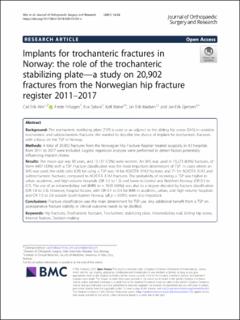| dc.contributor.author | Alm, Carl Erik | |
| dc.contributor.author | Frihagen, Frede | |
| dc.contributor.author | Dybvik, Eva Hansen | |
| dc.contributor.author | Matre, Kjell | |
| dc.contributor.author | Madsen, Jan Erik | |
| dc.contributor.author | Gjertsen, Jan-Erik | |
| dc.date.accessioned | 2021-08-09T08:47:54Z | |
| dc.date.available | 2021-08-09T08:47:54Z | |
| dc.date.created | 2021-04-17T12:58:10Z | |
| dc.date.issued | 2021-01-07 | |
| dc.identifier.issn | 1749-799X | |
| dc.identifier.uri | https://hdl.handle.net/11250/2766918 | |
| dc.description.abstract | Background
The trochanteric stabilizing plate (TSP) is used as an adjunct to the sliding hip screw (SHS) in unstable trochanteric and subtrochanteric fractures. We wanted to describe the choice of implant for trochanteric fractures with a focus on the TSP in Norway.
Methods
A total of 20,902 fractures from the Norwegian Hip Fracture Register treated surgically in 43 hospitals from 2011 to 2017 were included. Logistic regression analyses were performed to detect factors potentially influencing implant choice.
Results
The mean age was 83 years, and 15,137 (72%) were women. An SHS was used in 13,273 (63%) fractures, of them 4407 (33%) with a TSP. Fracture classification was the most important determinant of TSP. In cases where an SHS was used, the odds ratio (OR) for using a TSP was 14 for AO/OTA 31A2 fractures and 71 for AO/OTA 31A3 and subtrochanteric fractures, compared to AO/OTA 31A1 fractures. The probability of receiving a TSP was higher in urban, academic, and high-volume hospitals (OR 1.2 to 1.3) and lower in Central and Northern Norway (OR 0.3 to 0.7). The use of an intramedullary nail (IMN) (n = 7629 (36%)) was also to a degree decided by fracture classification (OR 1.8 to 5.3). However, hospital factors, with OR 0.1 to 0.4 for IMN in academic, urban, and high-volume hospitals and OR 1.5 to 2.6 outside South-Eastern Norway (all p < 0.001), were also important.
Conclusions
Fracture classification was the main determinant for TSP use. Any additional benefit from a TSP on postoperative fracture stability or clinical outcome needs to be clarified. | en_US |
| dc.language.iso | eng | en_US |
| dc.publisher | Springer Nature | en_US |
| dc.rights | Navngivelse 4.0 Internasjonal | * |
| dc.rights.uri | http://creativecommons.org/licenses/by/4.0/deed.no | * |
| dc.title | Implants for trochanteric fractures in Norway: the role of the trochanteric stabilizing plate—a study on 20,902 fractures from the Norwegian hip fracture register 2011–2017 | en_US |
| dc.type | Journal article | en_US |
| dc.type | Peer reviewed | en_US |
| dc.description.version | publishedVersion | en_US |
| dc.rights.holder | Copyright The Author(s) 2021 | en_US |
| dc.source.articlenumber | 26 | en_US |
| cristin.ispublished | true | |
| cristin.fulltext | original | |
| cristin.qualitycode | 1 | |
| dc.identifier.doi | 10.1186/s13018-020-02163-x | |
| dc.identifier.cristin | 1904766 | |
| dc.source.journal | Journal of Orthopaedic Surgery and Research | en_US |
| dc.source.pagenumber | 1-8 | en_US |
| dc.identifier.citation | Journal of Orthopaedic Surgery and Research. 2021, 16,26, 1-8. | en_US |
| dc.source.volume | 16 | en_US |

